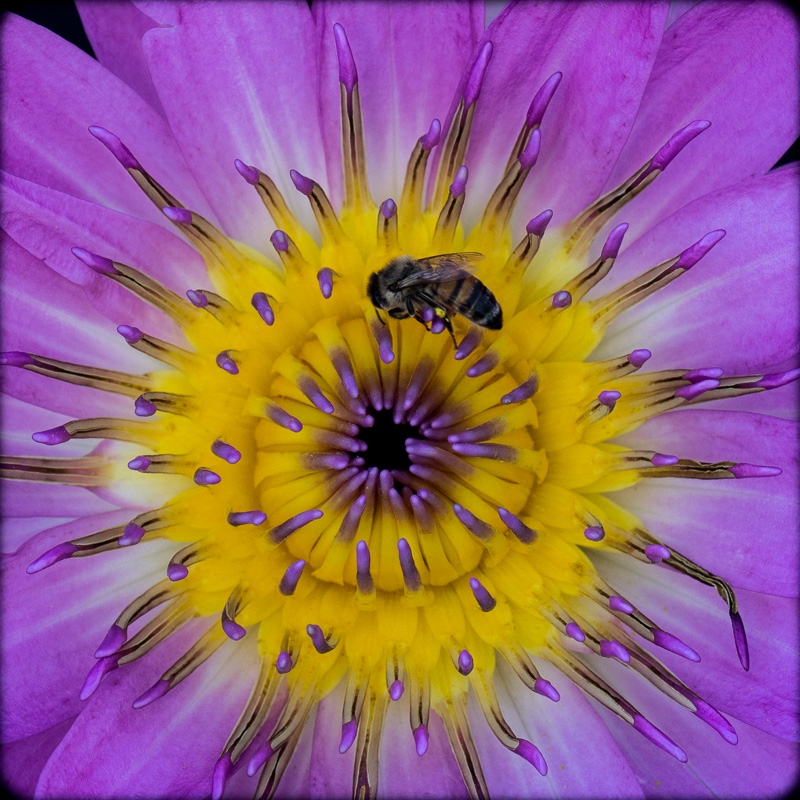


Nymphaea - My personal introduction to waterlilies
Andrea Wolff
Nobody sees a flower really; it is so small.
We haven't time, and to see takes time - like to have a friend takes time.
- Georgia O'Keeffe
I photographed my first waterlily in Bangkok 25 years ago. I was working at a Japanese newspaper in Tokyo and on a visit to Thailand with my father I could not resist taking a picture of such an exotic flower, the symbol of purity and enlightenment for Buddhists. Considering that it wasn’t an “important” picture, I was surprised to find myself placing it in my portfolio just because I liked looking at it so much. I still have that Kodachrome slide.
I photographed my second waterlily 11 years later at Longwood Gardens in Pennsylvania. I was using the same camera I had used in Thailand, but this time I was shooting negative film and making my own black-and-white prints in the darkroom. What a shock I had when I saw the pictures for the first time. I was awestruck by the beauty of those monochromatic images. I actually said to myself, “So that’s what waterlilies look like!” I had grown up entranced by the fuzzy gestures of color in Monet’s canvases of Nymphaea at Giverny. THAT was what waterlilies looked like.
When I was shooting the flowers I had been so overwhelmed by their incredible colors—pinks, purples, yellows—that I hadn’t fully appreciated their elegant forms. The sun had been reflecting off the water and it had been difficult to see everything that was going on. But looking at the photographs now, I saw the sunlight reflecting off the lily pads, I saw the small ripples in the water created by the soft breeze. These were the things that Monet had seen. I understood then that what the great man had been watching was the interaction between the light and the sky and the sky and the water and the water and the clouds. There was so much going on in a lily pond and it was all changing so quickly!
When I examined the pictures more closely, I also saw that there were thousands of spiky thorns covering the Amazonian water platters. And there were some Victoria lily buds submerged just beneath the surface of the water. Had they been there all the time and I hadn’t seen them or had they moved? Other flowers were partially closed or had shape-shifted in some way. These flowers had been transforming themselves before my eyes and I hadn’t even noticed because I was moving around so much myself. These flowers had secrets! I was hooked.
I returned to Longwood Gardens again that summer and again the following summer. I photographed at the Brooklyn Botanic Gardens and at Wave Hill. I photographed waterlilies laying flat on my stomach on the hot concrete surrounding the pools. I squatted and squinted and crouched and sweated. But my most vivid memory of that time was the night I got locked into the New York Botanical Gardens and had to climb out through the Conservatory window. The guard had apparently overlooked my motionless body, still as stone, waiting for the waterlilies to move.
Nymphaea - A fine art book by Andrea Wolff
Andrea Wolff
I decided that if I could paint that flower in a huge scale,
you could not ignore its beauty.
- Georgia O'Keeffe
Fine-art photographer Andrea Wolff presents “NYMPHAEA: A Visual Celebration of Waterlilies,” a book years in the making, an exploration of a flower that has been largely overlooked until now. This alluring book gives the reader the opportunity to disconnect from the information overload of our internet world and reconnect with the beauty and serenity of the natural world.
As a symbol of purity and enlightenment, transformation and rebirth, knowledge and spirituality, waterlilies and lotuses have played an important role in cultural iconography since antiquity. Ancient Egyptians regarded the blue waterlily as sacred since it represented the Sun and therefore rebirth. In the 20th century, artists incorporated waterlilies into their most famous creations, including Louis Comfort Tiffany, whose waterlily lamp was one of his most successful pieces. In the United States and Europe, everyone has an acquaintance, if not a full-on friendship, with Monet’s series of waterlily paintings.
Waterlilies have never before been photographed in such an intimate manner, so up-close and personal. Andrea has photographed them in their natural environment, allowing for the interplay of sunlight on water, pad and lily, and captures them not just in the prime of their lives, as most flowers are photographed, but as they first emerge as buds and as they last decline to seed.
“When you take a flower in your hand and really look at it, it's your world for the moment. I want to give that world to someone else.”
—- Georgia O’Keefe

Fine Art
Collections:Richard Gere Foundation, New York, NY
Alinari National Museum of Photography, Florence, Italy
Polaroid International Collections, Boston, MA